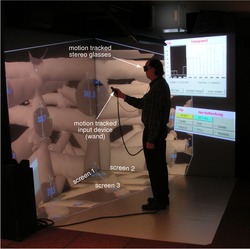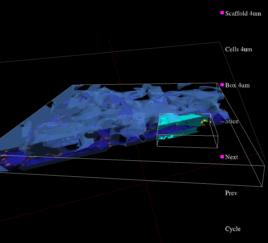Visualization of Tissue Engineering
Summary:
Tissue Engineering is an emerging, interdisciplinary field, involving cell biology and materials science. It involves the the development of biological materials that can repair, maintain, or enhance tissue function. Tissue engineering is full of promise for those in need of organ and tissue replacement and repair. To date, the commercial success of tissue engineered products has been largely unfulfilled.
The development of tissue engineered products is limited by the lack of laboratory imaging techniques which are capable of non-destructive imaging of the three-dimensional morphology as well as the cell response of a tissue engineering scaffold. In this project, a collinear optical coherence/confocal fluorescence microscope capable of high-resolution imaging of porous scaffolds has been developed. The combined data is then visualized in our interactive, immersive visualization environment in order to gain new insights into characteristics that promote cell growth and propagation. The ability to evaluate cell scaffold viability in this way will enable the developers of tissue engineered materials to minimize expensive and time-consuming animal studies.
In addition to the qualitative insights derived from the immersive visualizations, we have also implemented tools within the immersive environment that enable the user to directly interact with and to make measurements of the virtual representations of the data. We have created tools for measuring distance, angles and other properties in the immersive environment.
Additional Technical Details:
The immersive visualization used by the scientists is based on the open source software DIVERSE as well as additional software created in-house. The creation of the visualizations requires several steps:
- registration of the data from the various sources into a common 3D coordinate system,
- segmentation of the data into scaffold material, cell, and pore space,
- generation of 3D polygonal surfaces corresponding to the surfaces of cells and scaffold,
- creation of an interactive immersive display of data, and
- implementation of interactive measurement tools for deriving quantitative measurements from the virtual scene.
Publications:
-
J. Terrill, W. L. George, T. J. Griffin, J. Hagedorn, J. T. Kelso, M. Olano, A. Peskin, S. Satterfield, J. S. Sims, J. W. Bullard, J. Dunkers, N. S. Martys, A. O'Gallagher and G. Haemer, Extending Measurement Science to Interactive Visualization Environments, in Trends in Interactive Visualization: A-State-of-the-Art Survey, E. Zudilova-Seinstra, T. Adriaansen and R. Van Liere (Ed.), Springer, U.K., 2009.
Note: Pages: 207-302
-
J. Hagedorn, J. Dunkers, S. Satterfield, A. Peskin, J. Kelso and J. Terrill, Measurement Tools for the Immersive Visualization Environment: Steps Toward the Virtual Laboratory, Journal of Research of NIST, 112 (5), September-October 2007, pp. 257-270.
-
J. Hagedorn, J. Dunkers, A. Peskin, J. Kelso and J. Terrill, Quantitative, Interactive Measurement of Tissue Engineering Scaffold Structure in an Immersive Visualization Environment, Biomaterials Forum, 28, 2006, pp. 6-9 and cover.
-
J. Hagedorn, J. Terrill, J. Kelso and J. Dunkers, Measurement of Tissue Engineering Scaffolding Material delivered at DIVERSE Birds of a Feather session at SIGGRAPH 2006, Boston, MA, August 2006.
-
J. Dunkers, J. Hagedorn, A. Peskin, J. Kelso, J. Terrill and L. Henderson, Interactive, Quantitative Analysis of Scaffold Structure Using Immersive Visualization in Proceedings of the 2006 Summer Bioengineering Conference, Amelia Island, FL, June 2006.
-
J. E. Devaney, S. G. Satterfield, J. G. Hagedorn, J. T. Kelso, A. P. Peskin, W. L. George, T. J. Griffin, H. K. Hung and R. D. Kriz, Science at the Speed of Thought, in Ambient Intelligence for Scientific Discovery: Lecture Notes in Artificial Intelligence, 3345, 2005, pp. 1-24.
Related Publications:
-
F. A. Landis, M. T. Cicerone, J. A. Cooper, N. R. Washburn and J. P. Dunkers, Developing Metrology for Tissue Engineering: Collinear Optical Coherence and Confocal Fluorescence Microscopies, IEEE Bioimaging Conference Proceedings, April 2004.
-
M. T. Cicerone, J. P. Dunkers, N. R. Washburn, F. A. Landis and J. A. Cooper, Optical Coherence Microscopy for in-situ Monitoring of Cell Growth in Scaffold Constructs, 7th World Biomaterials Congress, 2004, p. 584.
-
J. P. Dunkers, M. T. Cicerone and N. R. Washburn, Collinear Optical Coherence and Confocal Fluorescence Microscopies for Tissue Engineering, Optics Express, 11 (23), January 2003, p. 3074.
- J. P. Dunkers and M. T. Cicerone, Scaffold Structure and Cell Function Through Multimodal Imaging and Quantitative Visualization, Biomaterials Forum, 25 (3), January 2003, p. 8.
Return to Visualization
|
Return to Visualization

Interactive measurement and analysis of tissue engineering scaffold material in the immersive visualization environment.

Overview of two scans of a tissue engineering cell scaffold at differing resolutions. The two scans are registered to the same coordinate system.

Detailed view of a portion of the registered data sets.

A portion of the immersive display showing several features of the system: interactive menus, 2D cross-sections, interactive clipping plane, and transparency.
Staff:
- Collaborating Scientist: Joy Dunkers
- Visualization: John Hagedorn, Steven Satterfield
- Group Leader: Judith Terrill
Links:
|




